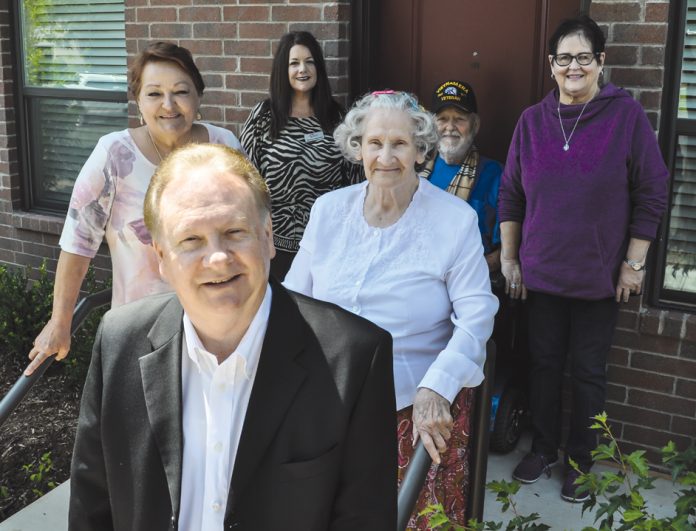
by Bobby Anderson
Staff Writer
Five years ago, a developer invited Roland J. Chupik’s Neighborhood Housing Services Oklahoma group to help rehabilitate Wesley Retirement Village located at NW 12 and Harvey.
The 85-unit apartment complex was formerly Wesley Hospital, which later became Presbyterian Hospital from 1911 to 1964.
“The marketing study that went along with that showed the need for senior independent living is just incredible,” said Chupik, the general manager of NHS Oklahoma. “There’s no way we’re meeting that need.”
In an effort to do just that the group turned its attention to the heart of the city, in particular along Classen Drive just north of St. Anthony Hospital.
The result is an astounding 48-unit complex that wows before you even make it through the door.
The Commons, located in a residential area in downtown Oklahoma City, already looks like a fixture between the booming Midtown District to the south and the coveted Mesta Park neighborhood to the north.
The newly-constructed, energy-efficient complex is designed for those 62 and older.
One-bedroom, two-bedroom and efficiency offerings come fully equipped with washer and dryer, microwave, stove/oven, garbage disposal, refrigerator and dishwasher.
“It’s amenity-rich in terms of providing what residents need,” Chupik said.
Over-delivering was the hallmark of the project.
“It was extremely important because we encounter that all the time – ‘not in my backyard,’” Chupik said of the affordable-living concept. “We wanted to show not only the neighborhood but the city and whoever was interested that affordable housing particularly for seniors doesn’t have to be what people think that might be.
“I think we nailed it on the head.”
The Commons gives residents quick access to several shopping locations.
Family and friends are welcome to enjoy the splash pad, tot lot and patio grills for an afternoon or evening.
Property staff attends to those day-to-day tasks that residents no longer have to concern themselves with such as lawn care and maintenance.
A fitness facility, computer lab and library are all located within the building.
“It goes back to our mission,” Chupik said.
The Commons is actually the group’s former headquarters.
“It’s just exceeded our expectations,” Chupik said. “When you talk to the residents they’ll tell you it’s the best place they’ve ever lived.”
A lot of time and effort – along with meetings with local neighborhood organizations – went into making sure the building and its footprint would fit seamlessly into the area.
Resident Manager Shannon Hitchcock said the interest in the property has been strong.
“(The waiting list) is going to be fairly long but right now I still have openings,” Hitchcock said. “I anticipate there will be a two or three-year waiting list.”
To help residents on a budget, the property was constructed with energy efficiency in mind. Foam insulation inside walls helps prevent energy loss while higher R-value windows help block excess heat from entering.
HISTORY OF HELPING
In the late 1970s, the country was facing a decline in the economy. The oil embargo hit Oklahoma particularly hard and neighborhoods began to turn into ghost towns as people fled homes they could no longer afford. The abandoned houses began to deteriorate and crime began to rise as a result.
A group of dedicated Oklahoma City residents fought to combat this by banding together and forming “Residents for Capitol Hill Improvement.” This organization petitioned the city to provide funding to help provide quality-housing options, which would help alleviate the decline.
Eventually this grassroots organization merged with NeighborWorks America, an organization dealing with the critical need for affordable housing across the country.
Over time, the grassroots organization evolved into Neighborhood Housing Services Oklahoma.
In 2016, the group celebrated its 35th anniversary and continues its dedication of helping create affordable, quality housing options and to help families create wealth.
Potential Commons residents must be 62 or older and meet income guidelines. The application process can usually be completed in less than a week.
Hitchcock said the majority of residents are active adults who are downsizing or coming from a less energy-efficient property.
“It’s important this process continues,” Chupik said. “This is the beginning but I don’t think we’ll end our mission for affordable housing. If it’s possible to build even better we’ll do that but I’m not so sure it’s possible.”













